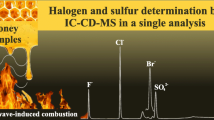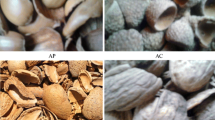Abstract
Microwave-induced combustion (MIC) was proposed in this study for honey decomposition aiming for As, Cd, Hg, and Pb determination by inductively coupled plasma mass spectrometry (ICP-MS). Sample mass (up to 1.0 g), absorbing solution (0.5 to 14.4 mol L−1 HNO3, and H2O), heating program, and combustion aids were evaluated. The Eurachem guidelines were used for method validation. The proposed method enabled combustion of a high sample mass (0.8 g of honey, with 0.4 g of microcrystalline cellulose and 100 µL of 6 mol L−1 NH4NO3) using 6 mL of an absorbing solution consisting of 1 mol L−1 HNO3, which resulted in low residual carbon in solution (< 25 mg L−1). Honey samples from different geographical origins were analyzed. Results showed no significant difference in comparison to other two microwave decomposition methods, based on microwave-assisted wet digestion with single reaction chamber (MAWD-SRC) and microwave-assisted wet digestion (MAWD). Standard addition experiments resulted in recoveries higher than 98%. The limits of detection ranged from 1.10 (As) to 4.60 ng g−1 (Pb). In addition to using only diluted reagents and resulting in digests virtually free of interferences, the proposed method was faster (< 30 min) than most of those presented in the literature.
Graphical Abstract






Similar content being viewed by others
References
Mizrahi A, Lensky Y. Bee products: properties, applications, and apitherapy. Boston: Springer; 1997. p. 269.
Silici S, Uluozlu OD, Tuzen M, Soylak M. Honeybees and honey as monitors for heavy metal contamination near thermal power plants in Mugla. Turkey Toxicol Ind Health. 2016;32(3):507–16.
Andrade CK, Anjos VE, Felsner ML, Torres YR, Quináia SP. Relationship between geographical origin and contents of Pb, Cd, and Cr in honey samples from the state of Paraná (Brazil) with chemometric approach. Environ Sci Pollut Res Int. 2014;21(21):12372–81.
Quazi S, Sarkar D, Datta R, Sharma S. Chapter 16 A greenhouse study on soil-arsenic forms and their bioaccessibility in two chemically variant Florida soils amended with sodium arsenate pesticide: Preliminary results. In: Sarkar D, Datta R, Hannigan R, editors. Developments in Environmental Science. 5: Elsevier; 2007;345–62.
Boskabady M, Marefati N, Farkhondeh T, Shakeri F, Farshbaf A, Boskabady MH. The effect of environmental lead exposure on human health and the contribution of inflammatory mechanisms, a review. Environ Int. 2018;120:404–20.
Codex. Revised Standard for Honey. STAN 12–1981: Codex Alimentarius Commission; 2001.
EU. Commission Regulation (EC) No 1881/2006 of 19 December 2006 setting maximum levels for certain contaminants in foodstuffs. European Union; 2006.
Codex. General standard for contaminants and toxins in food and feed. 1995.
Brasil. Instrução normativa Nº 88, de 26 de março de 2021. Estabelece os limites máximos tolerados (LMT) de contaminantes em alimentos. In: ANVISA, editor. 2021.
Atanassova J, Pavlova D, Lazarova M, Yurukova L. Characteristics of honey from serpentine area in the Eastern Rhodopes Mt., Bulgaria. Biol Trace Elem Res. 2016;173(1):247–58.
Conti ME, Canepari S, Finoia MG, Mele G, Astolfi ML. Characterization of Italian multifloral honeys on the basis of their mineral content and some typical quality parameters. J Food Compos Anal. 2018;74:102–13.
Czipa N, Andrási D, Kovács B. Determination of essential and toxic elements in Hungarian honeys. Food Chem. 2015;175:536–42.
Muller EI, Souza JP, Muller CC, Muller ALH, Mello PA, Bizzi CA. Microwave-assisted wet digestion with H2O2 at high temperature and pressure using single reaction chamber for elemental determination in milk powder by ICP-OES and ICP-MS. Talanta. 2016;156–157:232–8.
Spirić D, Ćirić J, Đorđević V, Nikolić D, Janković S, Nikolić A, et al. Toxic and essential element concentrations in different honey types. Int J Environ Anal Chem. 2019;99(5):474–85.
Wilschefski SC, Baxter MR. Inductively coupled plasma mass spectrometry: introduction to analytical aspects. Clin Biochem Rev. 2019;40(3):115–33.
Grindlay G, Mora J, de Loos-Vollebregt M, Vanhaecke F. A systematic study on the influence of carbon on the behavior of hard-to-ionize elements in inductively coupled plasma–mass spectrometry. Spectrochim Acta Part B At Spectrosc. 2013;86:42–9.
Flores EMM. Microwave-assisted sample preparation for trace element determination. Amsterdam: Elsevier; 2014. p. 400.
Bilandžić N, Tlak Gajger I, Kosanović M, Čalopek B, Sedak M, Kolanović BS, et al. Essential and toxic element concentrations in monofloral honeys from southern Croatia. Food Chem. 2017;234:245–53.
Quinto M, Miedico O, Spadaccino G, Paglia G, Mangiacotti M, Li D, et al. Characterization, chemometric evaluation, and human health-related aspects of essential and toxic elements in Italian honey samples by inductively coupled plasma mass spectrometry. Environ Sci Pollut Res Int. 2016;23(24):25374–84.
Barin JS, Flores EMM, Mesko MF, Mello PA, Pereira JSF. Chapter 5 - microwave-induced combustion. In: Flores EMM, editor. Microwave-Assisted Sample Preparation for Trace Element Analysis. Amsterdam: Elsevier; 2014. p. 143–77.
Schmidt L, Bizzi CA, Rosa FC, Cruz SM, Barin JS, Flores EMM. Microwave-induced combustion: towards a robust and predictable sample preparation method. New J Chem. 2017;41(14):6902–10.
Costa VC, Picoloto RS, Hartwig CA, Mello PA, Flores EMM, Mesko MF. Feasibility of ultra-trace determination of bromine and iodine in honey by ICP-MS using high sample mass in microwave-induced combustion. Anal Bioanal Chem. 2015;407(26):7957–64.
Mesko MF, Balbinot FP, Scaglioni PT, Nascimento MS, Picoloto RS, Costa VC. Determination of halogens and sulfur in honey: a green analytical method using a single analysis. Anal Bioanal Chem. 2020;412(24):6475–84.
Santos RF, Cruz SM, Krzyzaniak SR, Duarte FA, Mello PA, Flores EMM. Trace metal impurities determination in high-purity polyimide by plasma-based techniques. Microchem J. 2019;146:492–7.
Picoloto RS, Wiltsche H, Knapp G, Barin JS, Flores EMM. Mercury determination in soil by CVG-ICP-MS after volatilization using microwave-induced combustion. Anal Methods. 2012;4(3):630–6.
Rondan FS, Henn AS, Mello PA, Perez M, Bullock LA, Parnell J, et al. Determination of Se and Te in coal at ultra-trace levels by ICP-MS after microwave-induced combustion. J Anal At Spectrom. 2019;34(5):998–1004.
Rosa FC, Duarte FA, Paniz JNG, Heidrich GM, Nunes MAG, Flores EMM, et al. Dispersive liquid–liquid microextraction: an efficient approach for the extraction of Cd and Pb from honey and determination by flame atomic absorption spectrometry. Microchem J. 2015;123:211–7.
Flores EMM, Mello PA, Krzyzaniak SR, Cauduro VH, Picoloto RS. Challenges and trends for halogen determination by inductively coupled plasma mass spectrometry: a review. 2020;34(S3): e8727.
Mesko MF, Mello PA, Bizzi CA, Dressler VL, Knapp G, Flores EMM. Iodine determination in food by inductively coupled plasma mass spectrometry after digestion by microwave-induced combustion. Anal Bioanal Chem. 2010;398(2):1125–31.
Eurachem. Eurachem guide: the fitness for purpose of analytical methods – a laboratory guide to method validation and related Topics. 2 ed. Teddington: LGC; 2014.
Picoloto RS, Wiltsche H, Knapp G, Mello PA, Barin JS, Flores EMM. Determination of inorganic pollutants in soil after volatilization using microwave-induced combustion. Spectrochim Acta B: At Spectrosc. 2013;86:123–30.
Pereira RM, Costa VC, Hartwig CA, Picoloto RS, Flores EMM, Duarte FA, et al. Feasibility of halogen determination in noncombustible inorganic matrices by ion chromatography after a novel volatilization method using microwave-induced combustion. Talanta. 2016;147:76–81.
Pereira LSF, Iop GDI, Nascimento MS, Diehl LO, Bizzi CA, Barin JS, et al. Alternative igniters based on oxidant salts for microwave-induced combustion method. J Braz Chem Soc. 2016;27(3):526–33.
Döker S. Exploiting aerosol dilution for the determination of ultra-trace elements in honey by collision/reaction cell inductively coupled plasma mass spectrometry (CRC-ICP-MS) without thermal digestion. Anal Methods. 2017;9(11):1710–7.
Brasil. Decreto no 55871, de 16 de março de 1965. Normas reguladoras do emprego de aditivos para alimentos. In: ANVISA, editor. Brasília1961.
Funding
All the authors are grateful to Instituto Nacional de Ciência e Tecnologia de Bioanalítica (INCTBio, Process Number 88887.137487/2017–00). Erico M. M. Flores and Marcia F. Mesko are grateful to the Conselho Nacional de Desenvolvimento Científico e Tecnológico (CNPq, Grant Nr. 313786/2019–4, 409548/2021–9, 312271/2017–4); and Fundação de Amparo à Pesquisa do Estado do Rio Grande do Sul (FAPERGS, Grant Nr. 17/2551–0000960-6, 22/2551–0000389-3, 21/2551–0002091-1) for the support and to Coordenação de Vitória H. Cauduro, Gabriel T. Druzian, Mariele S. Nascimento, Fernanda P. Balbinot are thankful to Coordenação de Aperfeiçoamento de Pessoal de Nível Superior (CAPES, Finance code 001) for supporting this study.
Author information
Authors and Affiliations
Contributions
Vitoria H. Cauduro: Writing, review and editing; writing, original draft; methodology.
Camila M. A. C. Alves: Writing, original draft; methodology; validation; formal analysis.
Mariele S. Nascimento: Methodology, validation, formal analysis, investigation.
Gabriel T. Druzian: Methodology, validation, formal analysis, investigation.
Fernanda P. Balbinot: Methodology, validation, formal analysis, investigation.
Marcia F. Mesko: Conceptualization; writing, review and editing; supervision; funding acquisition; methodology; investigation.
Erico M. M. Flores: Conceptualization; writing, review and editing; supervision; funding acquisition; methodology; investigation.
Corresponding author
Ethics declarations
Conflict of interest
The authors declare that there is no conflict of interest associated with this study. Marcia Foster Mesko is guest editor of the topical collection “Elemental Mass Spectrometry for Bioanalysis” in Analytical and Bioanalytical Chemistry but was not involved in the peer review of this paper.
Additional information
Publisher's Note
Springer Nature remains neutral with regard to jurisdictional claims in published maps and institutional affiliations.
Published in the topical collection Elemental Mass Spectrometry for Bioanalysis with guest editors Jörg Bettmer, Mario Corte-Rodríguez, and Márcia Foster Mesko.
Rights and permissions
Springer Nature or its licensor (e.g. a society or other partner) holds exclusive rights to this article under a publishing agreement with the author(s) or other rightsholder(s); author self-archiving of the accepted manuscript version of this article is solely governed by the terms of such publishing agreement and applicable law.
About this article
Cite this article
Cauduro, V.H., Alves, C.M.A.C., Nascimento, M.S. et al. Microwave-induced combustion for further determination of potentially toxic elements in honey by ICP-MS. Anal Bioanal Chem 416, 2859–2870 (2024). https://doi.org/10.1007/s00216-024-05235-7
Received:
Revised:
Accepted:
Published:
Issue Date:
DOI: https://doi.org/10.1007/s00216-024-05235-7




